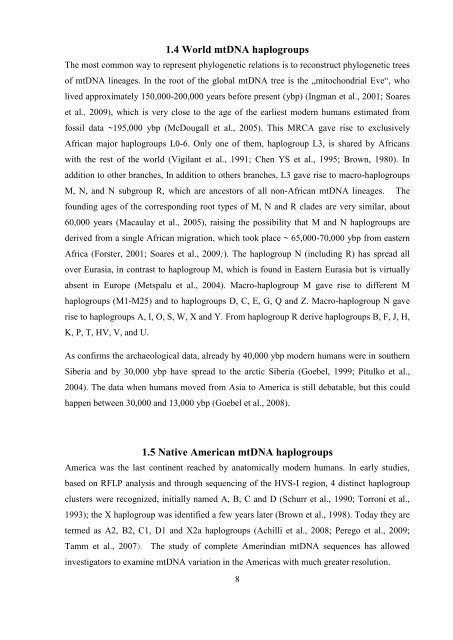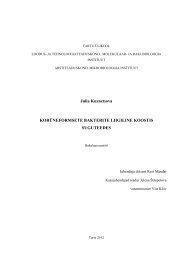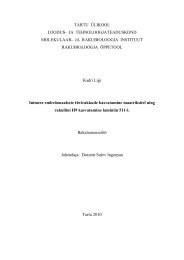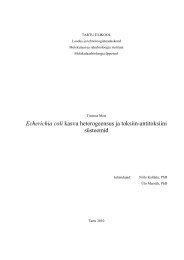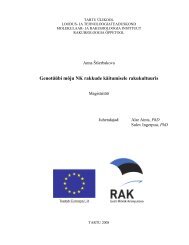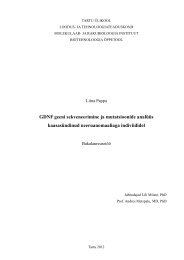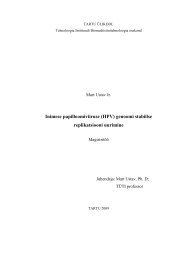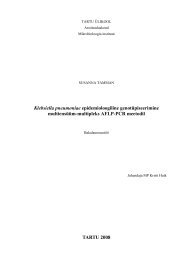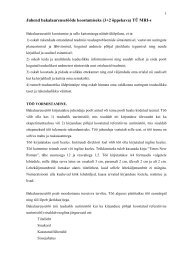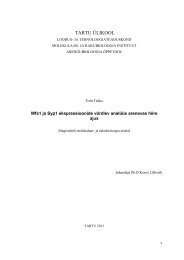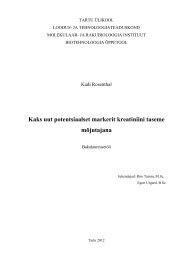Maternal variation in Huichol and Mixtec populations from Mexico
Maternal variation in Huichol and Mixtec populations from Mexico
Maternal variation in Huichol and Mixtec populations from Mexico
Create successful ePaper yourself
Turn your PDF publications into a flip-book with our unique Google optimized e-Paper software.
1.4 World mtDNA haplogroups<br />
The most common way to represent phylogenetic relations is to reconstruct phylogenetic trees<br />
of mtDNA l<strong>in</strong>eages. In the root of the global mtDNA tree is the „mitochondrial Eve“, who<br />
lived approximately 150,000-200,000 years before present (ybp) (Ingman et al., 2001; Soares<br />
et al., 2009), which is very close to the age of the earliest modern humans estimated <strong>from</strong><br />
fossil data ~195,000 ybp (McDougall et al., 2005). This MRCA gave rise to exclusively<br />
African major haplogroups L0-6. Only one of them, haplogroup L3, is shared by Africans<br />
with the rest of the world (Vigilant et al., 1991; Chen YS et al., 1995; Brown, 1980). In<br />
addition to other branches, In addition to others branches, L3 gave rise to macro-haplogroups<br />
M, N, <strong>and</strong> N subgroup R, which are ancestors of all non-African mtDNA l<strong>in</strong>eages. The<br />
found<strong>in</strong>g ages of the correspond<strong>in</strong>g root types of M, N <strong>and</strong> R clades are very similar, about<br />
60,000 years (Macaulay et al., 2005), rais<strong>in</strong>g the possibility that M <strong>and</strong> N haplogroups are<br />
derived <strong>from</strong> a s<strong>in</strong>gle African migration, which took place ~ 65,000-70,000 ybp <strong>from</strong> eastern<br />
Africa (Forster, 2001; Soares et al., 2009;). The haplogroup N (<strong>in</strong>clud<strong>in</strong>g R) has spread all<br />
over Eurasia, <strong>in</strong> contrast to haplogroup M, which is found <strong>in</strong> Eastern Eurasia but is virtually<br />
absent <strong>in</strong> Europe (Metspalu et al., 2004). Macro-haplogroup M gave rise to different M<br />
haplogroups (M1-M25) <strong>and</strong> to haplogroups D, C, E, G, Q <strong>and</strong> Z. Macro-haplogroup N gave<br />
rise to haplogroups A, I, O, S, W, X <strong>and</strong> Y. From haplogroup R derive haplogroups B, F, J, H,<br />
K, P, T, HV, V, <strong>and</strong> U.<br />
As confirms the archaeological data, already by 40,000 ybp modern humans were <strong>in</strong> southern<br />
Siberia <strong>and</strong> by 30,000 ybp have spread to the arctic Siberia (Goebel, 1999; Pitulko et al.,<br />
2004). The data when humans moved <strong>from</strong> Asia to America is still debatable, but this could<br />
happen between 30,000 <strong>and</strong> 13,000 ybp (Goebel et al., 2008).<br />
1.5 Native American mtDNA haplogroups<br />
America was the last cont<strong>in</strong>ent reached by anatomically modern humans. In early studies,<br />
based on RFLP analysis <strong>and</strong> through sequenc<strong>in</strong>g of the HVS-I region, 4 dist<strong>in</strong>ct haplogroup<br />
clusters were recognized, <strong>in</strong>itially named A, B, C <strong>and</strong> D (Schurr et al., 1990; Torroni et al.,<br />
1993); the X haplogroup was identified a few years later (Brown et al., 1998). Today they are<br />
termed as A2, B2, C1, D1 <strong>and</strong> X2a haplogroups (Achilli et al., 2008; Perego et al., 2009;<br />
Tamm et al., 2007). The study of complete Amer<strong>in</strong>dian mtDNA sequences has allowed<br />
<strong>in</strong>vestigators to exam<strong>in</strong>e mtDNA <strong>variation</strong> <strong>in</strong> the Americas with much greater resolution.<br />
8


